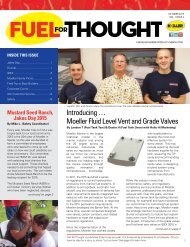2016_catalog_web
Create successful ePaper yourself
Turn your PDF publications into a flip-book with our unique Google optimized e-Paper software.
SAFETY MATTERS<br />
A few safety tips about filling the transport container:<br />
9 Do not fill any container while it is inside<br />
your boat.<br />
9 Only use an approved container.<br />
9 Keep container a safe distance away from<br />
other boats and boaters.<br />
9 Keep the nozzle in contact with the can<br />
during filling.<br />
9 Do not fill over the recommended fill line.<br />
9 Wipe down your container before putting it<br />
into your boat.<br />
A few words about safety during refueling:<br />
9 Shut off the motor and give it time to cool<br />
down before refueling.<br />
9 Don’t refuel near an open flame or close to a<br />
sparking situation.<br />
9 Keep a fire extinguisher handy.<br />
9 Don’t overfill the fuel tank. On hot days,<br />
allow for expansion.<br />
9 Don’t spill the fuel.<br />
For a video which demonstrates spout operation,<br />
go to http://www.theplasticsgroup.net/fuel_containers_us.php?id=SmartFill<br />
Moeller EPA-compliant USA jerry cans emphasize<br />
safety and convenience:<br />
9 Protective, child resistant dust Cap<br />
9 Self-venting SMART-FILL nozzle<br />
9 Top & bottom anchors for easy pours<br />
9 Safety collar for locking<br />
9 No external vent<br />
9 CARB-compliant and TSG-Approved<br />
DID YOU KNOW?<br />
Plastic Fuel Cans should be replaced every five<br />
years. One reason cans fail prematurely is because<br />
the cap cracks or breaks; that’s because<br />
too much pressure is applied when closing the<br />
cap. Just twist the cap until it’s tight, and it will<br />
last for five years!<br />
| 20






